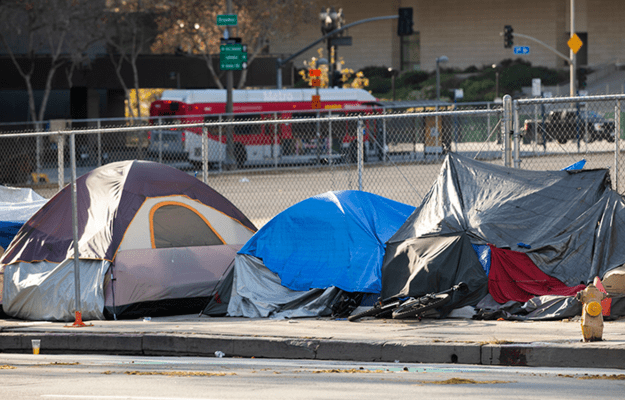
Three Strategies to Combat the Joint Legacy of Racial Segregation and Police Brutality in Public Housing
The movement for racial justice in the United States cannot progress without acknowledging the connection between our history of racial segregation and the disproportionate impact of police brutality on communities of color. Breonna Taylor was killed in her Louisville, Kentucky, home, in a neighborhood where residents often feel that “no rights are to be respected, whether it is... freedom from police violence or good schools.” Some remarked that George Floyd and the officer who killed him might as well have been living on different planets. Floyd grew up in Houston’s Third Ward—a ward with one of the lowest average incomes and largest Black population—and the officer, who owns two homes, lives in a suburb where almost 80 percent of residents are white. Akai Gurley was shot by a patrolling officer in the stairwell of his public housing complex in East New York, where more than 80 percent of residents are people of color.
Police brutality in the US is both a spatial problem and a racial one. The first publicly funded police forces were created to quash labor riots and enforce the bondage of African people, not to promote public safety. That legacy continues today, as police operate as an explicit means of public control over communities with less political power, which are often low-income communities of color. Through long-standing laws and policies, governments deploy militarized police to these communities instead of resources and support, and this joint impact of racial housing segregation and police brutality is especially prominent in today’s public housing developments.
How housing policy has contributed to police brutality in and around public housing
Past and present housing policies trap many low-income residents and people of color in “low-opportunity, high-poverty communities, furthering racial and ethnic segregation.” Black, Native American, and Latinx households, compared with white people, are more likely to rent and have a greater need for affordable housing, such as public housing, because of the perpetuation of racial discrimination in job access, educational attainment, and wage disparities. Nearly a century’s worth of federal and local policies have concentrated public housing developments in impoverished neighborhoods of color—the same neighborhoods where people of color are most likely to experience police violence.
Police are more likely to use force in low-income neighborhoods of color, where public housing is often located. States with higher degrees of residential segregation, a primary indicator of structural racism, experience higher racial disparities in police-related deaths. Militarized police deployment in general is also often targeted toward neighborhoods with large shares of Black residents. Public housing residents are also more likely to encounter the police and be arrested—partly because many US public housing authorities (including Annapolis, New York City, and Oakland) have their own dedicated police forces. Limitations on where to live can then further concentrate people of color in segregated, overpoliced neighborhoods. For example, criminal background screening policies (PDF) often confine where those with criminal records—disproportionately Black and Latinx people—are able to live.
Frequent police encounters in public housing and in neighborhoods of color can lead to the notion of “racial incongruity,” or the idea that each racial group belongs in its own geographic area. Some courts have supported racial incongruity as a factor for establishing reasonable suspicion for conducting stops, which then leads to more encounters and arrests—a vicious cycle that reinforces stereotypes of racial criminality and entangles more people of color in the criminal justice system.
A lack of Fourth Amendment legal protections, such as prohibiting unreasonable search and seizures, disproportionately affects people of color. Such protections are effectively nonexistent in public housing and other places deemed “high crime.” Court cases such as United States v. Diaz reveal how concern for officer safety in high-crime areas and existing legal exceptions strip public housing residents of their legal protections—police can stop and search any residents for “loitering” in the halls of their residential complexes.
Another example of policing tactics that functionally bypass Fourth Amendment protections is New York City’s stop and frisk policy, which overwhelmingly targets Black people. The policy was inspired by the broken windows theory, which suggests that increased policing of minor crimes helps deter more serious crimes. The theory has since been criticized for contributing to the “widespread criminalization” of people of color.
State-level and municipal-level laws, such as nuisance and crime-free housing ordinances, further increase the likelihood of a police confrontation for people of color, who are disproportionately affected by such laws. These laws often create incentives for landlords to evict tenants and their families, drastically increasing the risk of homelessness (PDF). The criminalization of people experiencing homelessness in cities across the country then makes these people more vulnerable to police confrontations (PDF). Increases in such confrontations directly relates to increased police use of force, which can be lethal.
Toward a broader vision of justice
Evidence shows frequent police presence and use of force are seen disproportionately in neighborhoods of color. To allow people to feel protected in their homes and neighborhoods, state and local policymakers can consider how to address the connections between policing, public housing, and neighborhood change.
- Reinstate Fourth Amendment protections for people living in public housing. Because public housing is considered public property, public housing residents, many of whom are people of color, are not protected from unreasonable searches and seizures. Reinstating protections from unreasonable searches and seizures in public housing reaffirms dignity and could build trust between residents and building managers. Increased trust may mean building managers are less likely to seek police help for minor issues, reducing the likelihood of police violence. Although federal changes may be difficult, states and localities could consider exercising their authority over policing practices in public housing.
- Abolish antiloitering laws and nuisance ordinances that condemn people for existing in their own homes. Antiloitering laws and nuisance ordinances (PDF) result in evictions when crimes occur or when police are called. This discourages residents from calling the police (PDF) in times of crisis and is particularly dangerous for people experiencing domestic violence. Abolishing these laws can both ensure crimes are properly reported and tenants continue to be housed, thereby decreasing the chances of police encounters.
- Harness the full potential (PDF) of the Fair Housing Act to challenge overpolicing and its collateral effects. In Antioch, California, more than 800 Black residents challenged their local government in a lawsuit (PDF) for discriminatory policing practices intended to force Black people out of white suburbs by targeting people in publicly subsidized housing. The case resulted in a joint settlement between the plaintiffs and the city, signaling the need for further action on similar fronts. Another lawsuit (PDF) successfully challenged a criminal background check requirement when applying for housing that automatically rejected applicants if they have any criminal history. These requirements disproportionately affect applicants of color (PDF) because they are overrepresented in the criminal justice system. The housing management company agreed to change their policy (PDF), noting that the policy was inconsistent with the Fair Housing Act.
Evidence shows there needs to be a closer examination of how policing relates or perpetuates residential racial segregation. It is time to acknowledge what should have been realized long before the deaths of Breonna Taylor, George Floyd, Akai Gurley, and innumerable others. States and municipalities need alternative tools to address community safety, strategies that acknowledge the long racial and spatial history of policing.
Annie Chen is a current fourth-year undergraduate at Rice University, double majoring in political science and philosophy. She is a current research assistant at the Baker Institute for Public Policy and copresident of the Baker Institute Student Forum, a campus organization dedicated to promoting policy awareness. Megan Russo is a current second-year law student and Toll Public Interest scholar at the University of Pennsylvania Carey Law School. Before law school, Russo was a research analyst and project manager for the Urban Institute’s Justice Policy Center. This blog post was written under the supervision of Sarah Carthen Watson, associate counsel in the Fair Housing and Community Development Project of the Lawyers’ Committee for Civil Rights Under Law, where Chen and Russo spent a summer as an undergraduate and legal intern, respectively.
Photo by a katz/Shutterstock


